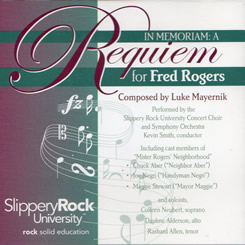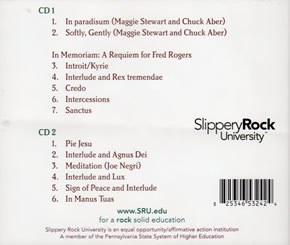In Memoram: A Requiem for Fred Rogers
Artist: Slippery Rock University Concert Choir and Symphony Orchestra with Chuck Aber, Joe Negri, and Maggie Stewart
Date: 2004
Format: CD
Label: Slippery Rock University
UPC: 825346532424


Track List
Disc 1
- In paradisum (Maggie Stewart and Chuck Aber)
- Softly, Gently (Maggie Stewart and Chuck Aber)
- Introit / Kyrie
- Interlude and Rex tremendae
- Credo
- Intercessions
- Sanctus
Disc 2
- Pie Jesu
- Interlude and Agnus Dei
- Meditation (Joe Negri)
- Interlude and Lux
- Sign of Peace and Interlude
- In Manus Tuas
Program Notes
In Memoriam: A Requiem for Fred Rogers began as an idea in the heart and mind of Maggie Stewart who was known and loved as Mayor Maggie from Mister Rogers’ Neighborhood. In the spring of 2003, Maggie Stewart and Chuck Aber (Neighbor Aber) approached Luke Mayernik, a talented young composer from Pittsburgh, to compose a work in honor of their recently departed colleague and friend. Mayernik began the daunting task of selecting texts and bringing together a plethora of musical ideas. It only made sense to start with the traditional Latin Requiem as a springboard, and movements I-II and V-VII come from this inspiration. The other movements of the eleven-movement work combine Latin, English, and Hebrew texts collected from a variety of sources.
Movement I, Introit and Kyrie is scored for choir, orchestra, and soloists (tenor and mezzo-soprano). The movement opens with a fervent, yet peaceful plea from the tenor soloist, for eternal rest and perpetual light to shine on both the departed and those who mourn. The mezzo-soprano soloist takes over the prayer and prays for mercy. The choir eventually takes this plea for mercy as its own prayer and the intensity increases. The tenor rejoins the choral prayer with the original plea for eternal rest. The section ends with the mezzo-soprano soloist now adding to the tenor’s plea for eternal rest. The movement has moments of desperation, but overall evokes a calm sense of assurance that the prayer has been heard and will be answered. The alternation between the soloists and the ensemble symbolizes both the corporate prayer of the spiritual community and the individual prayer of one in mourning.
Movement II, Rex tremendae, is based on a medieval text and includes the text of the Dies Irae. Many composers have chosen to musically depict this “Day of Wrath,” but Mayernik chose to maintain a certain sense of serenity in the midst of this troubling text. The orchestra opens the movement alone, and the choir eventually enters, part by part, building a massive cluster chord, each part chanting a different verse of the text.
Movement III, Credo, is part of the traditional Latin Mass, but not the traditional Requiem. Mayernik, however, chose to include this movement, but uses a non-traditional text. “I believe in the sun, even though it’s late in rising. I believe in love, even though it is absent. I believe in God, even though he is silent.” The text comes from “Holocaust Poetry” compiled by Hilda Schiff. This movement is the crux of the entire meaning of the work. Again, the composer has chosen to state a belief in something that moves beyond the realm of emotion, to a deep sense of faith and assurance in the midst of grief. The soloist interjects “Animaamin,” which is Hebrew for “I believe.”
Movement IV is a simple set of intercessions, or prayers, set for a cappella choir and percussion. The prayers are interspersed with dramatic readings written by Jason Greiner, a friend of Mayernik’s.
The Sanctus, movement V, is a triumphant setting of this traditional text. Scored for full orchestra and choir, the brass and percussion certainly lend an air of regality to the proceedings.
Movement VI, Pie Jesu is another prayer for peace presented by solo and orchestra. This movement features the composer at the piano.
Mayernik’s setting of the Agnus Dei is for a cappella choir and alto solo. Another prayer for rest and peace, this movement depicts the very thing that it is seeking – rest.
Meditation serves as an orchestral interlude. Originally conceived as the traditional “Elevation,” the composer chose to move it from its normal location, after the Sanctus, and allow it to simply be a time of reflection.
The ninth movement, Lux, is based on the traditional Lux aeterna, which is traditionally a prayer for spiritual light and guidance. The text chosen for this movement comes from the Biblical book of Ecclesiastes, chapter 11, verse 7. At different points throughout the piece the listener hears the almost inaudible cries of the heart, “Truly the light is sweet.” This movement serves as a final affirmation that the prayers for peace and rest have been heard and answered.
The penultimate movement, The Sign of Peace, seems to be intended for the hearer. The prayers have been offered for the departed and now the tenor soloist along with the orchestra offers words of encouragement to those who mourn, “Peace be with you.”
The Requiem concludes with a setting of the ancient Latin text, “In manus tuas, Domine, commendo spiritum meum,” or “Into your hands I commend my spirit.” This text has a twofold purpose. First it serves as a final prayer for the spirit of the departed, but more importantly it serves as the prayer of those left behind. It is a calm realization that life is fleeting, but that there is peace to be found both here and beyond.
“I believe Mister Rogers was a modern day prophet,” Mayernik said. “He was living gospel. This piece is not about me. It’s about the singers. It’s about the people involved. It’s about the music. It’s about humanity – a belief in humanity.”
Fred Rogers, who received an honorary doctorate from Slippery Rock University, truly had a belief in humanity and the good in everyone. He consistently encouraged children to embrace their humanity with all of the emotions and experiences that are a part of it; to always seek to learn and grow; to accept others and to love unconditionally.
The students, faculty, and administration of Slippery Rock University consider it a high honor to join with cast members, the composer, and the community to celebrate the life of one of America’s finest citizens and one of the best advocates for the rights of children everywhere.
Notes by Kevin Smith, conductor
Notes
Full concert program available online in PDF format.
Originally performed on Sunday, February 29, 2004 at St. Justin Church in (Mt. Washington) Pittsburgh, PA and on Tuesday, March 2, 2004 at Butler County Community College in Butler, PA.
Credits
Performed by the Slippery Rock University Concert Choir and Symphony Orchestra
Including cast members of Mister Rogers' Neighborhood: Chuck Aber, Joe Negri, Maggie Stewart
and soloists Collen Neubert (soprano), Daphne Alderson (alto), Rashard Allen (tenor)
Composed by Luke Mayernik
Conducted by Kevin Smith
